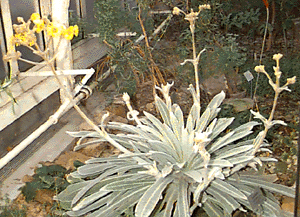Greenhouses - House L
|
The greater part of this house is reserved for plants of the temperate to subtropical zone of the southern hemisphere including southern South America, southern Africa, Australia, and New Zealand. Another thematic display shows insectivorous plants. Characteristic families of the Australian plant kingdom are represented by the grass tree family Xanthorrhoeaceae with Xanthorrhoea preissii. The specimen shown here only now slowly starts to form a trunk but flowers regularly. The heath-like Epacridaceae with the genus Epacris and Myoporaceae with the genus Myoporum are present as well. Important genera of Proteaceae are Banksia, Hakea and Isopogon. The grass genus Spinifex is interesting for its large capitate, spiny inflorescences. From the holantarctic plant kingdom the genera Crinodendron, Lapageria and Luzuriaga can be found here. Families from the southern hemisphere are the Proteaceae, Restionaceae and Stylidiaceae with several examples shown here, but there is not room enough for Araucariaceae (see House Pb). The genera Aristotelia, Araucaria, Griselinia, Hebe, Luzuriaga and Selliera occur in southern South America and New Zealand but not in southern Africa, while the Restionaceae occur in Australia and southern Africa. Restionaceae like Elegia capensis, species of Leptocarpus and Restio look much like Equisetum at first sight, another remarkable example of convergent evolution. Further interesting plants considered to be endangered species are the shrubby Freylinia visseri (Scrophulariaceae) from South Africa, and particularly the large cabbage-like Dendroseris litoralis of the sunflower family from the Juan Fernandez Islands far off the coast of Chile. Well-known and widespread, the genus Fuchsia is popular for its numerous showy cultivars and hybrids. Here, however we show only some native species. The widespread Fuchsia magellanica is the ancestor of many cultivated forms, Fuchsia boliviana is impressive with its long tubular flowers, while Fuchsia lycioides has very small flowers. A heath-like shrub belonging of the Solanaceae is Fabiana imbricata with pretty white flowers, much less conspicuous Fabiana patagonica from the wind-swept plains of Patagonia. Of the verbena family, a plant with strongly perfumed flowers is Verbena illapelina from Chile. Oxalis gigantea is easily recognized a member of the Oxalidaceae even though its shrubby habit is most remarkable for the genus.
Another attraction in this glasshouse are some insectivorous plants: a large stand of Drosophyllum lusitanicum from Portugal and Morocco, Pinguicula species from Central America, several species of sundew (Drosera) mostly from South Africa and Australia, Cephalotus from Australia, Sarracenia and Darlingtonia from North America and Heliamphora from Venezuela. The largest genus of insectivorous plants is Utricularia but only few of these delicate plants are in cultivation here. One of the more robust and large-growing species is Utricularia reniformis. B. Leuenberger |
Continue the tour of the greenhouses...






 Espeletia schultzei is not from the southern hemisphere but grown here for convenience. The temperature regime of its habitat, the Paramo region of the Andes of Venezuela, cannot be imitated here but this plant grows quite well under the conditions given in this glasshouse and has even flowered in 1996 for the first time after many years.
Espeletia schultzei is not from the southern hemisphere but grown here for convenience. The temperature regime of its habitat, the Paramo region of the Andes of Venezuela, cannot be imitated here but this plant grows quite well under the conditions given in this glasshouse and has even flowered in 1996 for the first time after many years.